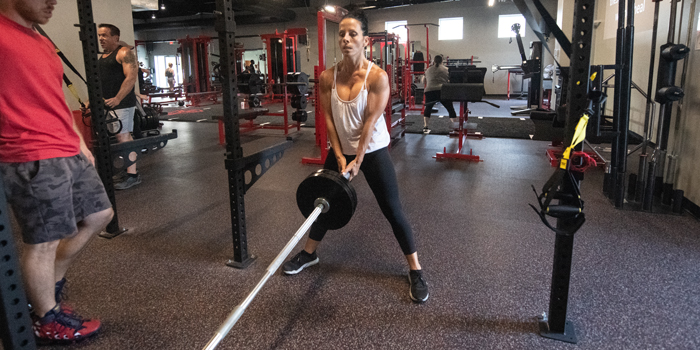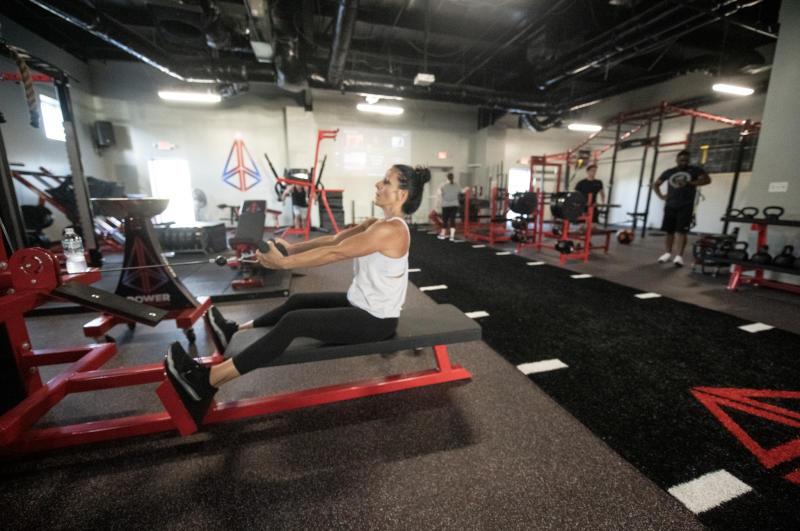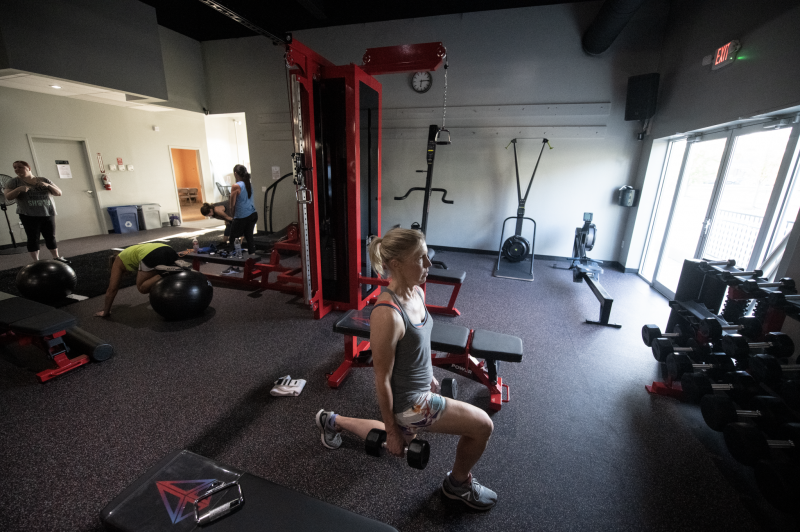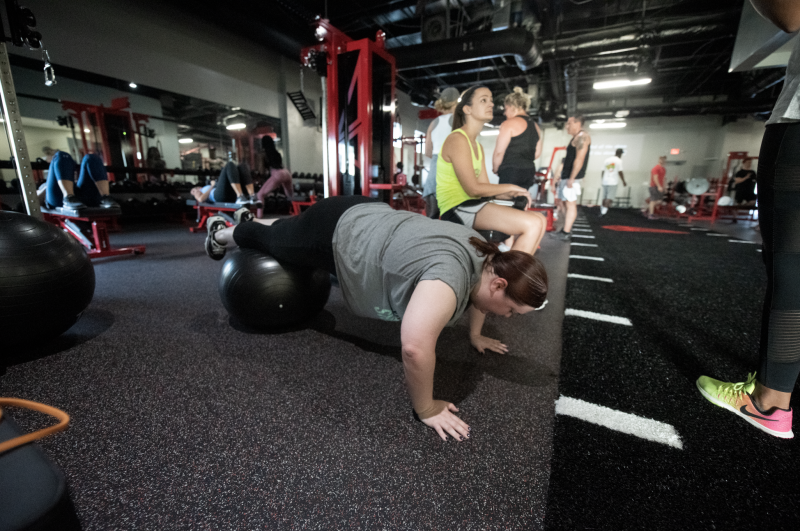
Say the word “conjugate” to a client, and it either means absolutely nothing to them or it conjures up the idea of a hardcore lifting environment. However, conjugate style systems are used all over the world with sports teams and small groups with great success.
I have a moderate-sized personal training client base comprised mainly of women of all ages with most at low or low-intermediate level ability and experience. Their goals are mostly to become leaner, healthier, and more well-rounded individuals; they’re not what first comes to mind when you think conjugate training. However, conjugate means using multiple aspects of training in conjunction with each other. It's a way of creating a system to suit your needs, or in this case, your clients’ needs.
RELATED: The Best Conjugate Training Plan
The setup I have created for my clients is based on their needs and goals, and yours should be representative of your or your clients’ needs and goals. I train my clients on a two-days-per-week schedule with extra given sessions for General Physical Preparedness (GPP) and a small amount of Specific Physical Preparedness (SPP).
The two sessions with myself are based mainly on a dynamic effort template. This is due to the lack of experience; we need the volume to build a motor program in basic lifting. This is very important with new lifters, as it takes roughly 300 to 500 reps to build a motor engram in the first instance; however, it can take 3,000 to 5,000 to replace a faulty one (Schmidt, 1991). Secondly, as I have mentioned previously, many of the clients’ goals aren’t based around max strength but general fitness and reducing body fat. Increased volume of activity is more in touch with these needs due to the energy expenditure increase it creates.
Here’s an example of a weekly schedule for my clients:
- Monday: Dynamic Lower Plus
- Tuesday: GPP or Conditioning
- Wednesday: Rest or Active Recovery
- Thursday: Dynamic Upper Plus
- Friday: GPP or Conditioning
- Weekend: Rest or Active Recovery
You will see that I also include rest or active recovery. I am a big fan of active recovery in many forms. Active recovery has been linked in peer-reviewed research to better recovery after resistance training.
Below you will find a breakdown of how I am currently templating my clients’ personal training sessions.
Dynamic Lower Plus
I use the RAMP method, which I was lucky enough to be taught by Ian Jefferies whilst at university. So during the warm-up, we raise the heart rate, activate and mobilise the areas used, and potentiate them by ensuring the exercises we use have a positive effect on the client's performance.
Example Dynamic Warm-Up (to be completed in a circuit 4-6 times, depending on ability):
- Kettlebell Swings x 10
- Walking Lunges x 10
- Moderate Height Box Jumps x 5
Box Squat Variation
I have a structure of exercises I wave initially to get clients squatting correctly and confidently. We use the box squat as it gives a definitive depth that I can adjust to coincide with ability and level, and box squats have been shown in research to be kinematically similar to the free squat.
When all is said and done, I’m essentially getting these clients moving in a safe and proficient way. Total squat volume depends on the individual as does set and rep selection. Exercise progression is usually as follows:
- Goblet Box Squat
- Safety Bar Box Squat
- Cambered Bar Box Squat
- Bow Bar Box Squat
- Straight Bar Box Squat
Examples of set and rep protocols and what I use them for:
- 5x5 learn the lift
- 10x3 higher total volume with more first lifts and setups to perfect form
- 5x6 the total volume is still 30 reps; however, now we have to maintain the position for longer
- 5x8 the highest total volume with a planned overload or hypertrophy aim
Advancements: Once I am happy that a client is proficient enough in the lift, we look at including the following to the lift:
- Accommodating resistance in the form of bands and chains
- 3-week waves. Once they are proficient we look to start to regulate the volume load in waves for them
Work ups, as proposed by Dave Tate in "The Periodisation Bible," are much more important here, as I’m only getting them to lift twice a week. We look to increase the working weight on the later sets of the workout to make the average weight lifted slightly higher than that of a usual dynamic workout.
READ: 5 Dynamic Effort Method Principles to Master
Deadlift Variation
As with the box squat, I like to structure the progression on the deadlift:
- Barbell Romanian Deadlift
- Trap Bar Deadlift
- Conventional Deadlift
- Sumo Deadlift
Examples of set and rep protocols and what I use them for:
- 5x5 learn the movement, hip hinge, or position
- 10x3 usual training volume, most first attempts, able to maintain bar speed and control without fatigue
- 5x6 the total volume is still 30 reps; however, now we have to maintain the position for longer
- 5x8 highest total volume, with a planned overload or hypertrophy aim; would not be used during the same session as the squat
Deadlift Assistance
This is where each client's needs really come into exercise selection, and rep and set selection along with rest periods. I do, however, have a usual structure of how I lay these out, which is as follows:
Hip Hinge Movement
- Cable Pull Through
- Banded Pull Through
- Dumbbell Romanian Deadlift
- Snatch Grip Romanian Deadlift
Single-Leg Movement
- Static Lunge
- Step Up
- Walking Lunge
- Split Squat
- Pistol Box Squat
Lower Back Movement
- Dumbbell Good Morning
- Banded Good Morning
- Reverse Hyperextension
- 45-Degree Back Raise
Trunk Movement
- Single-Arm Farmers Walk
- Leg Raise
- Bird Dog
- Crunch
- Side Bends
- Banded Oblique Twist
Dynamic Upper Plus
Here I use a RAMP-style warm-up, usually in a circuit focused on weaknesses.
Example Dynamic Warm-Up Circuit (completed 4-6 times):
- Battle Rope Whips 30 seconds
- Face Pulls x 20
- Straight Arm Pulldowns x 20
- Lying Ball Throws x 6 (explosive)
Pressing Variation
As a lot of my clients have not entered a gym prior to working with me, so I try to ensure that I don’t push progression too quickly here as many of my clients have poor strength and stability in the shoulder girdle. However, I find it very important to progress with correctly performed pressing movements to develop upper body strength for most of my everyday clients.
Example of progression:
- Incline Barbell Press Up
- Incline Barbell Press Up Reduced Incline
- Bench Press
- Floor Press
- Overhead Press
Advancements: I find it takes a lot longer to develop clients’ upper body strength compared to lower; however, once they’re proficient we add in several advancements.
- Accommodating resistance using bands or chains
- Lightened method using a reverse band or Slingshot-style device
- Waves of volume load
- Work up sets, again here to increase the average total intensity completed slightly
- Specialty bars and grip modifications to add increased variation into the plan (I’ve even been known to get clients to use a strongman log to mix things up)
Examples of set and rep protocols I use and why:
- 5x5 learn the movement
- 10x3 training volume with emphasis on form and power
- 3x10 training volume with emphasis on hypertrophy
- 5x6 training volume with emphasis on pure strength and extra time under tension compared to 10x3
- 5x8 increased training volume as planned overload or hypertrophy
Pressing Assistance
Again, this is where each client's needs come into exercise selection and rep and set selection along with rest periods; however, once again, I have a setup I like to use for this:
Upper Body Pulling Main
- Trx Row Variations
- Pull Down Variations
- Barbell Row Variations
- Dumbbell Row Variations
Pressing Assistance
- Dumbbell Arnold Press
- Dumbbell Floor Press
- Incline Dumbbell Press
- Press Up Variation
Shoulders
Triceps
- Overhead Dumbbell Extension
- Lying Dumbbell Triceps Extension
- JM Press
Biceps
- Hammer Curl
- Reverse Curl
- Dumbbell Curl
Clients’ Sessions Without Me
As mentioned already, I ask my clients to increase their weekly active time by adding in extra GPP sessions or active recovery. This generally aids in most of my clients’ needs by increasing overall energy expenditure, raising anaerobic and aerobic fitness, and helping to keep the client in a process of ever-increasing volume of training.

Here I will outline some of the exercises and tools used in this section of the clients’ weeks.
GPP
There are several options here as it is generally specific to the clients’ needs and ability along with home life constraints. Sometimes we forget people have lives outside of the training session.
- Sled dragging
- Sled pushing
- Circuit training classes
- Kettlebell classes and workouts
- Battle rope workouts
- Bodyweight workouts
Active Recovery
Again, there are several options here depending on goals, aims, and to be honest, recovery.
Discussion
You can see the layout and how I personally train many of my clients who have diverse goals. I was told periodisation and the selection of exercises and sets and reps are nothing more than being a strength and conditioning DJ at a mixing deck. As one trait comes up, slightly back off another, but never drop them out. That way you are always moving forward with a wide base of physical abilities to draw on. I believe this is easier to see with a conjugate setup.
LISTEN: Table Talk Podcast #29 — A Simple and Effective Template for Conjugate Training, Part 2
In this setup, we utilise the three methods of developing strength:
- Repetition effort method
- Dynamic effort method
- Max effort method (only when proficient form is present)
The whole setup actually draws on many of the key areas of development:
- Strength: from the methods mentioned above
- Speed: using the dynamic effort method and the RAMP from the warm-ups
- Power: increasing max strength, RAMP warm-up, and dynamic effort method
- Stamina: from the GPP sessions and the active recovery sessions
- Mobility: from the RAMP warm-ups and by learning correct functional lifting techniques
Although it’s in a greatly different setup compared to what would be seen as the usual conjugate system, I hope you can see the idea behind this is to adapt to the needs of the client and the constraints placed on them by real life. Not everyone can train four to five days a week. The main thing is to find what works for you and your clients and keep developing it.
With any luck, some of you currently training non-sporting clients may find this informative or interesting or at least thought-provoking.
Works Cited
- Drenowatz, Clemens, et al. “Differences in Energy Expenditure between High- and Low-Volume Training.” European Journal of Sport Science, vol. 13, no. 4, 2013, pp. 422–430., doi:10.1080/17461391.2011.635707.
- Mcbride, Jeffrey M, et al. “Comparison of Kinetic Variables and Muscle Activity During a Squat vs. a Box Squat.” Journal of Strength and Conditioning Research, vol. 24, no. 12, 2010, pp. 3195–3199., doi:10.1519/jsc.0b013e3181f6399a.
- Schmidt, Richard A., and Craig A. Wrisberg. Motor Learning and Performance. Langara College, 2004.
- Taipale, R.s., et al. “Active Recovery Shows Favorable IGF-I and IGF Binding Protein Responses Following Heavy Resistance Exercise Compared to Passive Recovery.” Growth Hormone & IGF Research, vol. 48-49, 2019, pp. 45–52., doi:10.1016/j.ghir.2019.09.001.
- Tate, Dave. “The Periodization Bible.” elitefts, www.elitefts.com/education/training/powerlifting/efs-classic-the-periodization-bible/.
- Zatsiorsky, Vladimir M., and William J. Kraemer. Science and Practice of Strength Training. Human Kinetics, 2006.
Luke Litchfield is from South Wales, U.K., and is a former international junior athlete in track and field and is currently a BPU British Champion powerlifter competing in single-ply. He graduated with first-class honors in sport and exercise science from the University of South Wales. He's putting his knowledge to use as a self-employed physical therapist. When he's not working or training, Luke can be found with his family.













Thanks